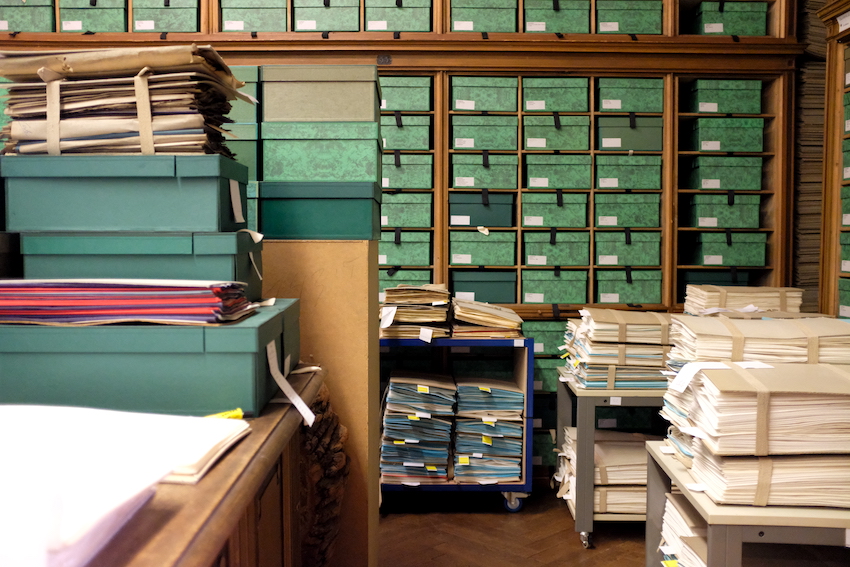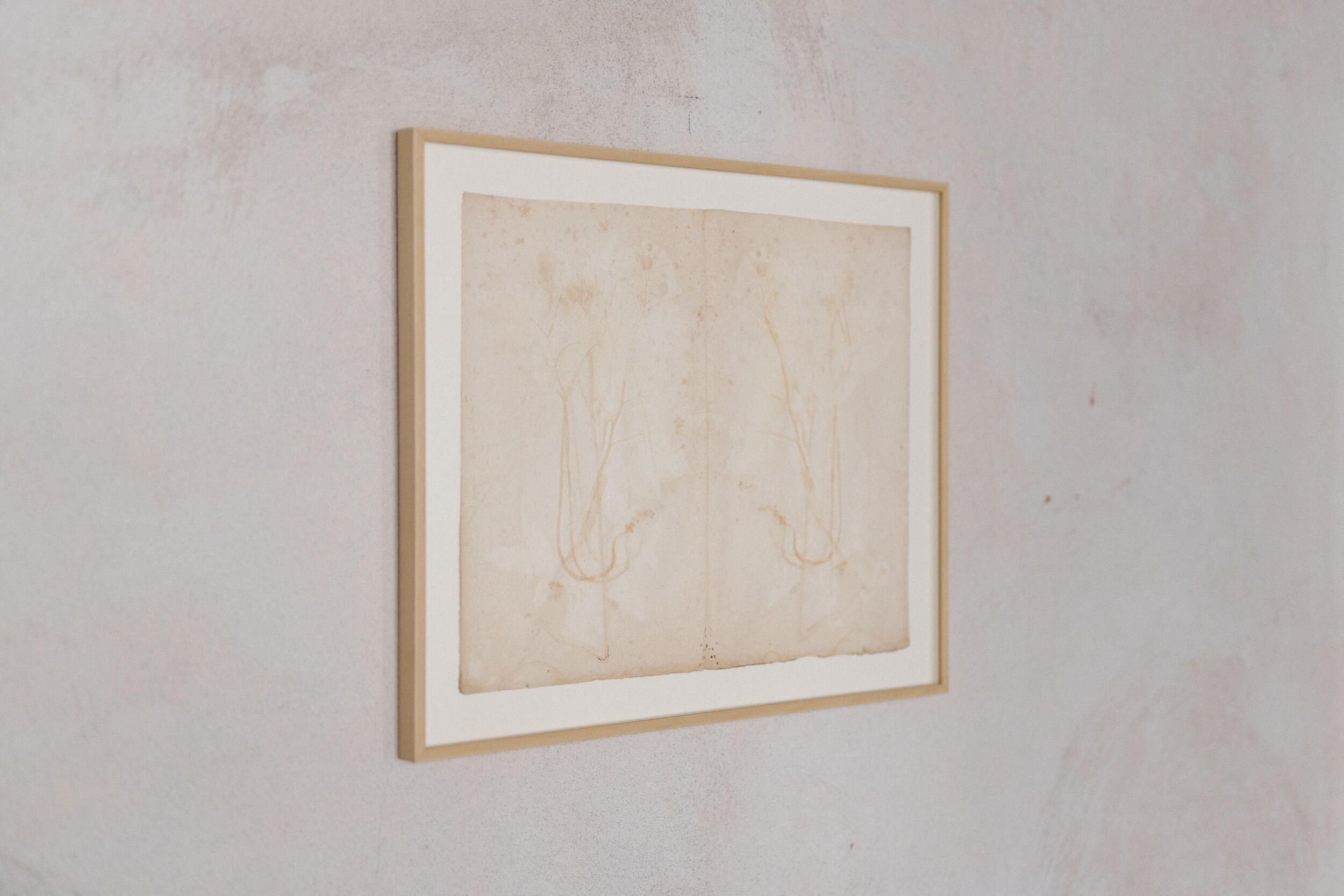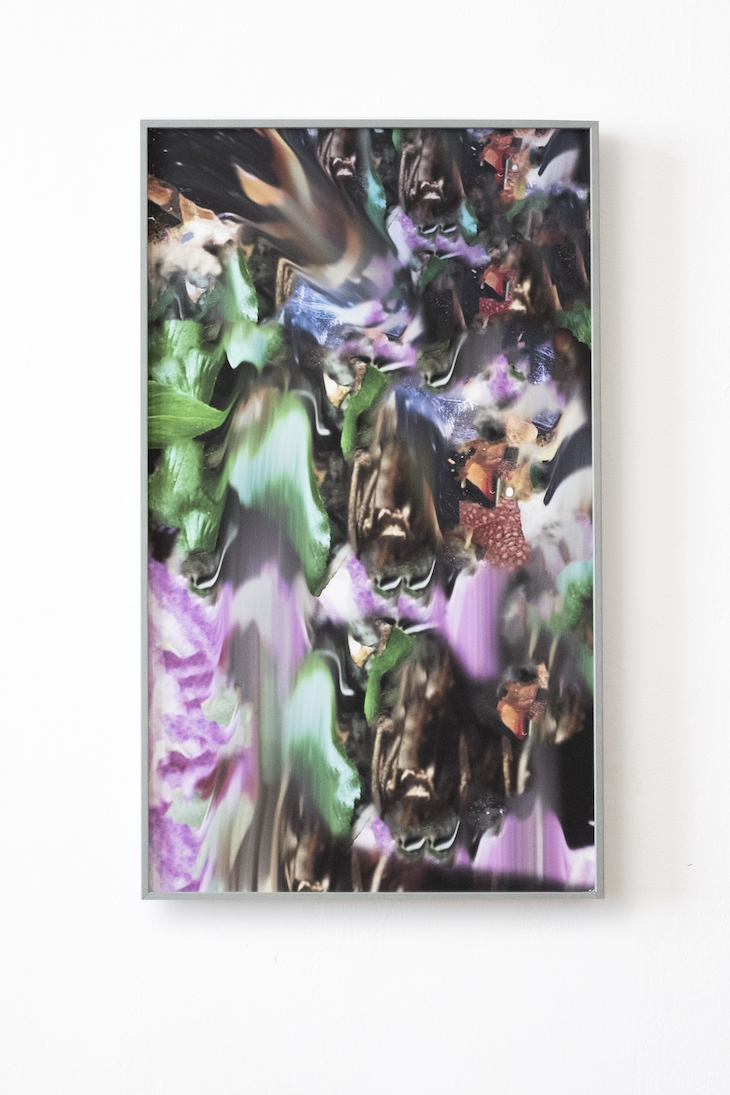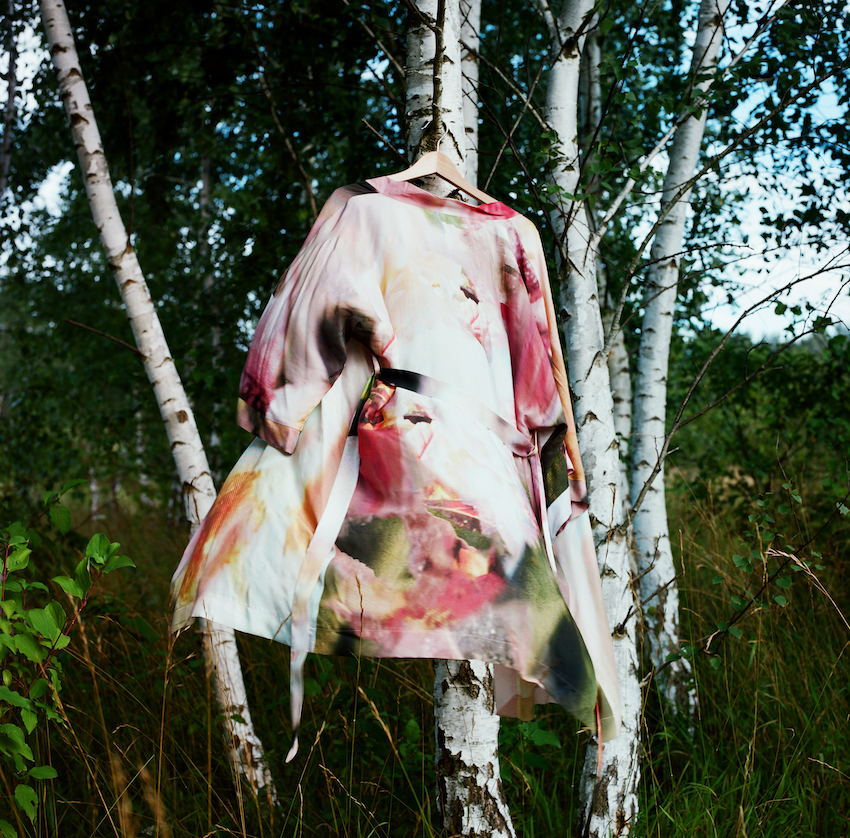
Ohne Titel (Cuscuta epilinum), Ohne Titel (Coleanthus Subtilis),Ohne Titel (Cuscuta epilinum), Ohne Titel (Bud Entanglement)
each 26 x 18 cm, 2023 (c) Theresa Wey
Collected
Series of collages from C-Prints (Fujicolor photo paper matte), 2023, Herbarium paper sheets from archives of the Natural History Museum Vienna, 2023“For her series begun in 2022, Michaela Putz explored the idea of archiving, image and reproduction. Starting from a „red list of ferns and flowering plants, which includes „vulnerable“ and „lost“ plants, she scoured the Internet for digital images of these endangered oreven extinct plant species and created a digital image archive, onthe one hand, and on the other, she inspected the herbarium of the botanical department in the Natural History Museum Vienna onsite and sifted through stacks of herbarium specimens. The two approaches could hardly be more different. For her contribution to the exhibition, she uses both sources, materializes immaterial things (image data are exposed) and shows quasi dematerialized things from the museum. In the course of restoration work at the Museumof Natural History, underground papers that are considered too damaged are repeatedly exchanged, or storage sheets in which plants were waiting to be processed into herbarium specimens are discarded. For this purpose, the plants are carefully detached fromtheir paper substrates and removed so that only their imprints remain - such as those left by woody stems in the handmade papers, stored for decades in folders and stacked on top of each other - as if transferred to the soft paper with an embossing stamp.” - Ruth Horak, translated by Paula Marschalek

Exhibition view “Between Light & Shadow” with Hessam Samavatian (c) Theresa Wey
“Exhibits are therefore also such „empty“ sheets of paper, on which, however, traces of the original plants are still clearly visible. In a figurative sense, the invisible, which is listed as lost throughout Austria, is made visible again: Michaela Putz‘s archive includes photographs of endangered plant species collected on the web, including the often detailed descriptions of their various stages of life - for example, the Artemis Alba with buds, its feathery foliage, blossoms, seed stand, but also its amazing scent of cola is described by the user:inside. Image data are exposed as C-prints and these (always) rectangular photographs are cropped in a next step, some follow the outlines of flowers, others take on new organic forms. Different stages of life are combined and composed into collages. Even the otherwise invisible screen on which Michaela scrolls along her search results becomes visible when the artist photographs some of the plants from the screenand a keyboard partially burned into the Retina display of the Macbook after years of use becomes visible as a bright outline, just like dust, scratches or fingerprints. Even tools of image processing, such as the magnifying glass, become part of the composition. But especially with the decision to compose blurred parts in an intertwined way, Michaela Putz takes back the pragmatics of the fact-based research work and gives the plants back their sensuality.” - Ruth Horak, translated by Paula Marschalek

Photo from the research in the Natural History Museum Vienna, 2023, (c) Michaela Putz, Bildrecht

Ohne Titel (Linaria arvensis), 100 x 70 cm, 2023 (c) Theresa Wey

Ohne Titel (Artemis alba), 100 x 70 cm, 2023 (c) Theresa Wey

Exhibition view “Between Light & Shadow” with Hessam Samavatian (c) Theresa Wey

Ohne Titel (Orchis coriophora), 26 x 18 cm, 2023 (c) Theresa Wey

Untitled (Paper Archaeology) 56,8 x 47,8 cm, handmade paper, empty herbarium sheet with traces of plants, from the archive of the Natural History Museum Vienna, 2023

Ohne Titel (Linaria arvensis), 26 x 18 cm, 2023 (c) Theresa Wey

Untitled (Paper Archaeology) ca. 40 x 30 cm, handmade paper, empty herbarium sheet with traces of plants, from the archive of the Natural History Museum Vienna, 2023

Untitled (Paper Archaeology), handmade paper, empty herbarium sheet with traces of plants, from the archive of the Natural History Museum Vienna, 2023

Untitled (Paper Archaeology) ca. 40 x 30 cm, handmade paper, empty herbarium sheet with traces of plants, from the archive of the Natural History Museum Vienna, 2023

Detail from Extinction Ballads #3, 2021
Extinction Ballads
Series of digitally processed found footage images of recently extinct/critically endangered plant species Fine art prints on Hahnemühle Photo Rag Ultra Smooth
dimensions from 75x45 cm to 125 x 75 cm (Ed. 2+2)
2021 - 2023
Request more information about the works
“The digital works include found-footage footage of recently extinct or endangered plants. Michaela Putz translates the evidence of former diversity into a transfiguring baroque aesthetic, interrupted only by the smudgy traces of the often inconsequential scrolling we find on our tablets and smartphones. In the work, the artist refers to a conspicuously invasive-destructive element of human action as well as to the increasingly evident futility of fleeting ‘gestures’.” - translated from a text by Esther Mlenek
The series “Extinction Ballads” is a visual investigating of found footage digital image archives of lost and threatened plants species that Michaela Putz started in 2021. She finds these images online, photographs them directly from the screen and hence making digital artifacts and the material qualities of the screes like dirt and dust and fingerprints part of the image world as a representation of today’s image culture where the screen is always part of what we look at. The extinct and threatened species - taken from the up to date list of Austrian Red List, where the artist is located - roam the image worlds as fragments only. Fragments that could be caused by endless scrolling, the flash light of the camera (since the images are being photographed from the screen, their final resting place), and the careless cut-outs of the plants in their now emptied environments with image editing tools. Putz digitally processes these images, integrating fragments of search histories, 3D models, open browser tabs, and texts. The images are built in layers, taking into account methods that the artist took from her research in the herbarium collection of Austria’s Natural History Museum. The resulting collages go beyond representation, encompassing pixellized realities that mirror our interconnected digital world and question the role of digital image archives as an act of preservation and caring in the time of mass extinction.



Exhibition View (SOLO) ABIES ALBA
Karlsplatz Vienna
C-Prints on Alu Dibond, Lacqueur
125x75cm each, unique works
See more exhibition views︎︎︎
Realised with the kind support of:




Fotos: Michèle Yves Pauty | Models: Pipa Pastell & James Habineza
VFMK x MICHAELA PUTZ
ARTIST ROBE EXTINCTION BALLADS
Was bleibt nach dem Untergang der Dinge? Aus welchem Stoff ist unsere Erinnerung? Und welche Bedeutung kommt der digitalen Archivierung zu?
Die Artist Robe EXTINCTION BALLADS entstand aus einer Zusammenarbeit des Verlag für moderne Kunst mit Michaela Putz. Der limitierte Kunstdruck auf gewebter Viskose entlehnt seine Bildwelt der gleichnamigen Werkserie der Künstlerin. In EXTINCTION BALLADS erkundet die gebürtige Burgenländerin visuelle Dimensionalitäten digitaler Bildarchive von ausgestorbenen und gefährdeten Pflanzenarten. Die Artist Robe ist ein Kunstwerk, das Berührung zulässt – mit einer Botschaft, die unter die Haut geht.
Zur Artist Robe EXTINCTION BALLADS
In einer von globalen Krisen durchzogenen Zeit, in der das sogenannte Doom-Scrolling zur ersten Tätigkeit am Morgen geworden ist, wird der Mensch in eine zunehmend kapitulierende Haltung gedrängt. Wie können wir uns von dieser Passivität befreien, uns wieder mit unserer Umwelt identifizieren, Erfahrungen der Resonanz erleben – Empathie und Hoffnung empfinden?
Mit der Artist Robe EXTINCTION BALLADS versucht Putz, sich dieser Fragen anzunehmen und durch sie ein Moment der Identifikation, der (Be-)Rührung zu ermöglichen. „Der Stoff geht uns nahe, bis an die Haut”. In den Werken der Serie EXTINCTION BALLADS schwingt ein Echo stiller Anerkennung und entschiedenen Aufrufs zugleich. Mit dem Artist Robe wird dieses in die Welt getragen.


Hardfacts
-
Artist Robe EXTINCTION BALLADS
-
VFMK x MICHAELA PUTZ
-
Die Artist Robe ist ein limitierter Kunstdruck aus der Serie EXTINCTION BALLADS.
-
Auflage: 15 Stück
-
Material: 100% gewebte Viskose, im Reaktivdruck bedruckt / aus Gründen des Tierschutzes wurde keine Seide verwendet
-
Umsetzung: Die KÜMMEREI, FAIRtigung Textil, Wien
Zum Fotoshooting
Für das Shooting wählte die Künstlerin das Naturschutzgebiet Lobau nördlich der Donau. Als eine der letzten intakten Au-Landschaften Europas, auch in Hinblick auf die wochenlangen Proteste gegen den geplanten Bau des Lobau-Tunnels im Jahr 2006, steht diese repräsentativ für die Verteidigung der Artenvielfalt und den aktiven Schutz unserer Umwelt.
Zur Serie EXTINCTION BALLADS
In EXTINCTION BALLADS hinterfragt Putz die Rolle digitaler Bildarchive als Akt der Konservierung in einem Zeitalter des voranschreitenden Massensterbens.
Von rund 500 in Österreich dokumentierten Biotoptypen ist die Hälfte von vollständiger Vernichtung bedroht, stark gefährdet oder gefährdet. Mit diesen über Jahrmillionen entstandenen spezifischen Lebensräumen ist auch die Zukunft der dort angesiedelten Tier- und Pflanzenwelt ungewiss.
Aktuelle Studien des Umweltbundesamts zeigen deutlich, dass der Artenrückgang bei den Farn- und Blütenpflanzen ungehindert fortschreitet.
-
1.274 Farn- und Blütenpflanzen stehen auf der “Roten Liste” Österreichs
-
66 Arten sind heute österreichweit ausgestorben oder verschollen
- 235 Arten sind akut vom Aussterben bedroht
Das fortlaufende Projekt EXTINCTION BALLADS ist eine visuelle Annäherung an die Frage, ob Verlorenes digital fortbestehen kann – und falls ja, in welcher Qualität.


Michaela Putz erkundet die Modi der Erinnerung in einer zunehmend digitalisierten Welt. Hierzu lässt sie sich sowohl operativ als auch ästhetisch auf die Schnittstelle zwischen immaterieller Digitalität und unserer eigenen Körperlichkeit ein, die sich unweigerlich zu dieser verhält. Found-Footage wird als Bild im Bildschirm fotografiert. Es entstehen Aufnahmen, die materielle Qualitäten wie Schmutz, Staub und Fingerabdrücke inkorporieren. Diese sich überlappenden Bildwelten fungieren als Signifikanten einer visuellen Bildkultur, in welcher der Screen immer Teil dessen ist, was wir betrachten.
Die ursprünglich abgebildeten Pflanzen erscheinen nur noch als Fragmente im luftleeren Raum – als Versatzstücke einer früheren Vergangenheit, die durch unaufhörliches Scrollen, das Blitzlicht der fotografierenden Kamera und die grenzenlose Möglichkeit der Reproduktion und Rekontextualisierung verfremdet werden. In der digitalen Bearbeitung der so schichtweise aufgebauten Bilder integriert Putz ebenso Ausschnitte von Suchverläufen und Browser-Tabs sowie vereinzelte Textstücke. Die entstandenen Collagen beherbergen verpixelte Realitäten, die die Komplexität unserer vernetzten Welt in sich aufnehmen und widerspiegeln. Das vorgebliche Vakuum der digitalen Sphäre scheint so gesprengt und wird von Raum und Zeit durchflutet.
“Michaela Putz übersetzt die Zeugnisse einstiger Vielfalt in eine verklärende Barockästhetik, unterbrochen nur von den schmierigen Spuren des oft belanglosen Scrollens, wie wir sie auf unseren Tablets und Smartphones finden. Die Künstlerin verweist in der Arbeit auf ein auffällig invasiv-destruktives Element menschlichen Handelns sowie auf die evidenter werdende Zwecklosigkeit flüchtiger „Gesten“.”
- Esther Mlenek
Photos: (c) Marko Risovi, 2021
Hypercene/Hipercen
Interactive Installation in public space for Mikrogalerija CPN in Belgrade/Serbi with Mato LagatorDecember 2021 - February 2022
The interactive installation for the Mikrogalerija CPN in Belgrade took upon the issues of the digitalization of our everyday lives and the consequences that such everyday life creates – rare metal mining, energy consumption, planned obsolescence of technology, electronic waste, social ignorance of the implications of the comfort that digital technologies provide. It questionned the knowledge of the components that our computers are made of, what minerals are in the batteries of our phones and where these raw materials have been excavated before they ended up in the devices.
A temperature sensitive layer on the front window revelaed more information about these questions and the hidden digital traces of the “hypercene”.
Program:
Panel Discussion about “the digital and the anthropocene” at the center for the promotion of science on December 2nd.
Photos: (c) Marko Risovi, 2021





Photo: (c) Marko Risovi, 2021
